Related Research Articles

Theodoricthe Great, also called Theodoric the Amal, was king of the Ostrogoths (475–526), and ruler of the independent Ostrogothic Kingdom of Italy between 493 and 526, regent of the Visigoths (511–526), and a patrician of the Eastern Roman Empire. As ruler of the combined Gothic realms, Theodoric controlled an empire stretching from the Atlantic Ocean to the Adriatic Sea. Though Theodoric himself only used the title 'king' (rex), some scholars characterize him as a Western Roman Emperor in all but name, since he ruled a large part of the former Western Roman Empire described as a Res Publica, had received the former Western imperial regalia from Constantinople in 497 which he used, was referred to by the imperial title princeps by the Italian aristocracy and exercised imperial powers recognized in the East, such as naming consuls.
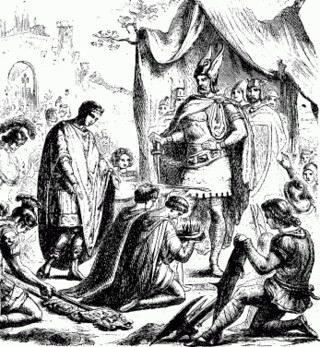
Year 476 (CDLXXVI) was a leap year starting on Thursday of the Julian calendar. At the time, it was known as the Year of the Consulship of Basiliscus and Armatus. The denomination 476 for this year has been used since the early medieval period, when the Anno Domini calendar era became the prevalent method in Europe for naming years.
The 470s decade ran from January 1, 470, to December 31, 479.
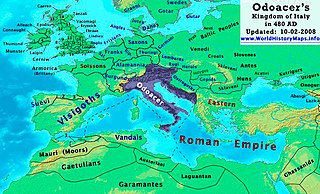
Year 480 (CDLXXX) was a leap year starting on Tuesday of the Julian calendar. At the time, it was known as the Year of the Consulship of Basilius without colleague. The denomination 480 for this year has been used since the early medieval period, when the Anno Domini calendar era became the prevalent method in Europe for naming years.
The 490s decade ran from January 1, 490, to December 31, 499.
The 450s decade ran from January 1, 450, to December 31, 459.
The 440s decade ran from January 1, 440, to December 31, 449.
The 460s decade ran from January 1, 460, to December 31, 469.

Year 466 (CDLXVI) was a common year starting on Saturday of the Julian calendar. At the time, it was known as the Year of the Consulship of Leo and Tatianus. The denomination 466 for this year has been used since the early medieval period, when the Anno Domini calendar era became the prevalent method in Europe for naming years.
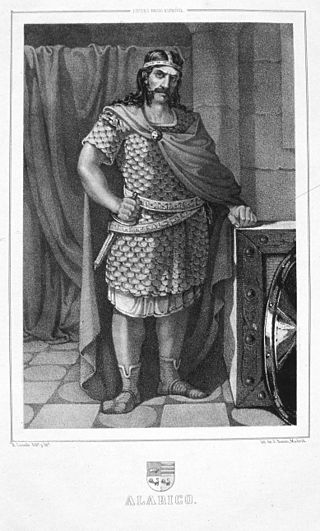
Year 484 (CDLXXXIV) was a leap year starting on Sunday of the Julian calendar. At the time, it was known as the Year of the Consulship of Venantius and Theodoricus. The denomination 484 for this year has been used since the early medieval period, when the Anno Domini calendar era became the prevalent method in Europe for naming years.
Year 488 (CDLXXXVIII) was a leap year starting on Friday of the Julian calendar. At the time, it was known as the Year of the Consulship of Ecclesius and Sividius. The denomination 488 for this year has been used since the early medieval period, when the Anno Domini calendar era became the prevalent method in Europe for naming years.
Year 471 (CDLXXI) was a common year starting on Friday of the Julian calendar. At the time, it was known as the Year of the Consulship of Novus and Probianus. The denomination 471 for this year has been used since the early medieval period, when the Anno Domini calendar era became the prevalent method in Europe for naming years.
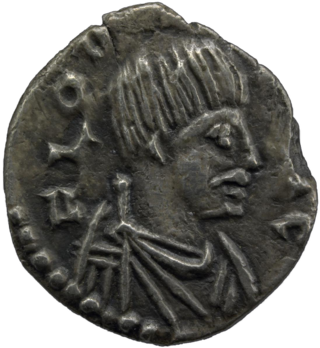
Odoacer, also spelled Odovacer or Odovacar, was a barbarian soldier and statesman from the Middle Danube who deposed the Western Roman child emperor Romulus Augustulus and became the ruler of Italy (476–493). Odoacer's overthrow of Romulus Augustulus is traditionally understood as marking the end of the Western Roman Empire.

Julius Nepos, or simply Nepos, ruled as Roman emperor of the West from 24 June 474 to 28 August 475. After losing power in Italy, Nepos retreated to his home province of Dalmatia, from which he continued to claim the western imperial title, with recognition from the Eastern Roman Empire, until he was murdered in 480. Though Nepos' successor in Italy, Romulus Augustulus, is traditionally deemed the last western Roman emperor, Nepos is regarded by some historians as the true last emperor of the west, being the last widely recognised claimant to the position.

Zeno was Eastern Roman emperor from 474 to 475 and again from 476 to 491. He was originally from the district of Isauria, which is now part of modern day Turkey, and changed his name from Tarasis to Zeno while serving under Leo I.
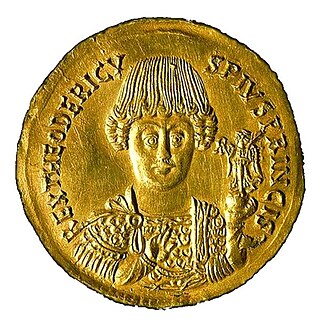
The Ostrogothic Kingdom, officially the Kingdom of Italy, existed under the control of the Germanic Ostrogoths in Italy and neighbouring areas from 493 to 553.
John the Scythian was a general and a politician of the Eastern Roman Empire who fought against the usurper Leontius (484–488) and in the Isaurian War (492–497).

Odoacer's deposition of Romulus Augustus, occurring in 476 AD, was a coup that marked the end of the reign of the Western Roman Emperor last approved by the Western Roman Senate and the creation of the Kingdom of Italy, although Julius Nepos exercised control over Dalmatia until 480.

The Eastern Roman Empire was ruled by the House of Leo from AD 457, the accession of Leo I, to 518, the death of Anastasius I. The rule of the Leonid dynasty coincided with the rapid decline, collapse and eventual fall of the Western Roman Empire. Following the end of the Western Empire, Emperor Zeno abolished the position of Western Roman Emperor and declared himself the sole Roman Emperor. The Eastern Roman Empire would come to last for several more centuries, and subsequent dynasties would invest large amounts of resources in attempts to retake the western provinces.
References
- ↑ https://www.britannica.com/place/Kyiv/History
- ↑ Duchesne, Liber Pontificalis, p. 249. "Hic sepultus est in basilica beati Petri apostoli, vi non. martias. Et cessavit episcopatus dies vi." Thiel, p. 174 §1. Jaffé, Regesta pontificum Romanorum I, p. 80. Loomis, p. 107.
- ↑ "CATHOLIC ENCYCLOPEDIA: Pope St. Felix III". www.newadvent.org. Retrieved 2024-01-04.
- ↑ R.A. Markus, Gregory the Great and his world (Cambridge: University Press, 1997), p. 8
- ↑ Wickham, Chris (2005). Framing the Early Middle Ages: Europe and the Mediterranean 400-800. OUP Oxford. p. 88.
- ↑ saintpatrickdc.org Archived June 13, 2017, at the Wayback Machine : Saints of March 23
- ↑ "Xiaowendi | emperor of Wei dynasty | Britannica". www.britannica.com. Retrieved 2022-07-15.
- ↑ Ponsonby-Fane, Richard. (1959). The Imperial House of Japan, p. 42.
- ↑ Imperial Household Agency (Kunaichō): 顕宗天皇 (23); retrieved 2013-8-29.
- ↑ "Boethius (480-524) - Anicius Manlius Severinus Boetius: Of the consolation of philosophy : in five books / made English and illustrated with notes by the Right Honourable Richard Lord Viscount Preston". www.royalcollection.org.uk. Retrieved 23 June 2018.